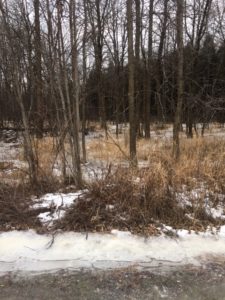I think people who live along the Lake have to be just a little more patient than those in the rest of the State. Now that Spring has arrived, there will be a period of a couple months where we hear over and over on weather forecasts that it will be “cooler along the Lake.” We are constantly tantalized and taunted by forecasts from Green Bay promising nice 50 and 60 degree days only to face the reality of yet another day in the low 40’s here. It should make us better people, but I’m not sure that is actually the case.
Even the seemingly cool weather of early spring is enough to bring about a great awakening in the forest. Each trip out to the preserve this time of year yields something new. Even though the snow has just melted there are birds, absent in winter, arriving to take their places- red-shouldered hawks are back where we suspect they’ve nested the last few years, brown creepers prowl the tree trunks and phoebes perch looking for bugs. Sandhill cranes are paired up and strolling the prairie, and tundra swans fly overhead in giant “V”s. A Coopers hawk snatches a cardinal at the bird feeders, and a merlin zooms past at high speed, heading for the marsh. Birds are moving constantly now, with returning migrants showing up almost every morning.
Even though it’s just above freezing, wood frogs are thawing out and moving from the winter shelter in the leaves slowly toward ponds and swales where they’ll soon start singing. More and more garter snakes are emerging from underground dens to sluggishly find warm places. Many of them are food for other animals despite their foul odor defense.
Foxes and coyotes have or will be having their young now in dens, along with squirrels in the trees and rabbits in their warrens, in anticipation of warmer and greener times to soon come. In another month their young will experience spring for themselves above ground. Turkeys are calling now, the toms trying to look especially impressive for the hens, and their rivals. The swales in the swamp are home to many mallards and wood ducks and a few woodsy Canada geese.
And although they don’t look any different than a month ago, the trees are preparing for spring as well. Although they still appear dormant, one has only to tap a maple tree to observe the sap moving from root to branch. Our maple syrup program for school children is coming to an end for the year, but the trees have been lately producing sap in abundance, on its way up to feed the new leaves that in six weeks will erupt from the branches. So much of the life in the forest depends on the trees, but sometimes we barely pay attention to them. What an exciting time this must have been for Native people and early settlers, who would have been busy making the sugar they needed after a long winter.
A visit to the forest to witness this natural awakening can awaken something in us also. Stepping out of our normal lives to experience the reality of the natural world is refreshing, uplifting, and interesting. Except when that reality is filled with mosquitoes and they will awaken soon enough!
